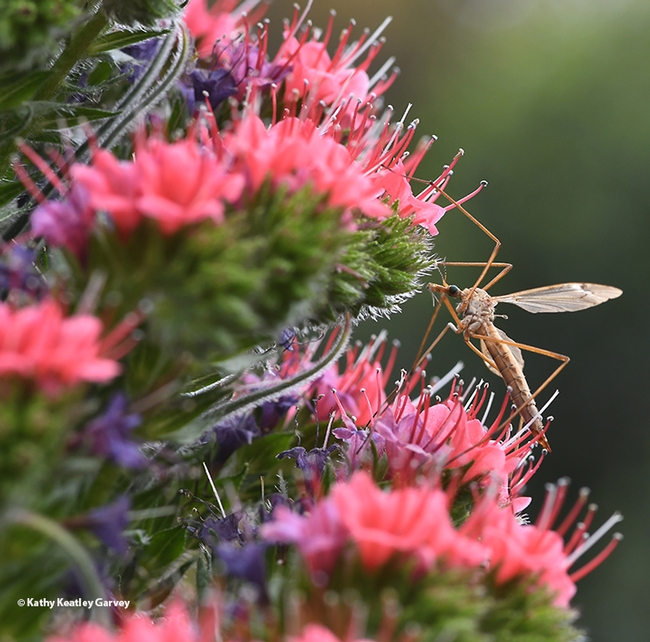They're out there, and you don't have to crane your neck to see them.
Some folks mistakenly call them "mosquito hawks" or "mosquito eaters," but they are neither. They are crane flies, members of the family Tipulidae of the order Diptera (flies).
They're everywhere.
We've been seeing the slender, gangly, goofy-looking insects, Tipula oleracea, bump into walls and flower pots. This one (below) glided into the tower of jewels, Echium wildpretii, and just remained there for several minutes.
Lynn Kimsey, director of the Bohart Museum of Entomology and UC Davis distinguished professor of entomology, emphasizes that they don't eat mosquitoes. "In fact, adult crane flies generally don't eat at all," she points out. "Their entire brief adult lives are spent searching for mates and laying eggs." Crane flies are attracted to lights at night and you may find them around your porch light.
"Adult crane flies emerge from the soil beneath turfgrass, pastures and other grassy areas in late summer and fall," according to the UC Statewide Integrated Pest Management Program, part of the UC Agriculture and Natural Resources.. "The adults have very long legs and resemble large mosquitoes. Females mate and lay eggs in grass within 24 hours of emerging. Eggs hatch into small, brown, wormlike larvae that have very tough skin and are commonly referred to as leatherjackets. The leatherjackets feed on the roots and crowns of clover and grass plants during the fall. They spend the winter as larvae in the soil; when the weather warms in spring, they resume feeding. During the day larvae mostly stay underground, but on damp, warm nights they come to the surface to feed on the aboveground parts of many plants. When mature, the larvae are about about 1 to 1½ inch long. Around mid-May they enter a nonfeeding pupal stage and remain just below the soil surface. In late summer, pupae wriggle to the surface and the adults emerge. There is one generation a year."
This one (below) didn't find a mate on the tower of jewels but it did find a towering view. The plant can reach 10 feet in height.
Attached Images:
